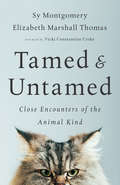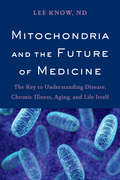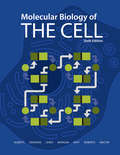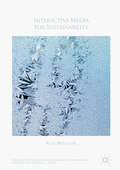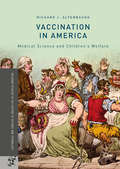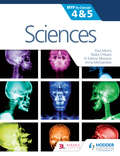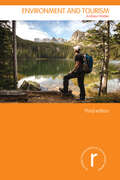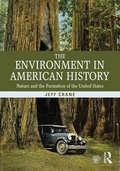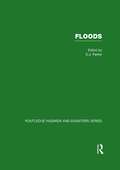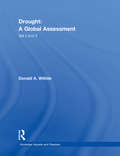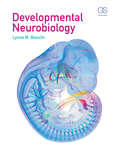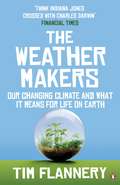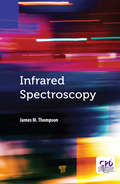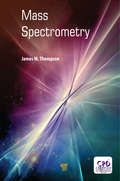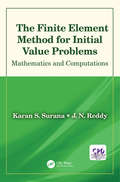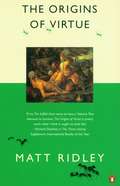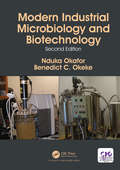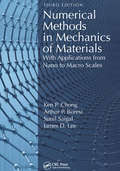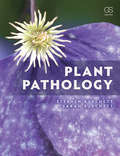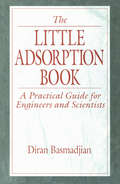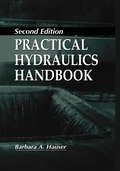- Table View
- List View
Tamed and Untamed: Close Encounters of the Animal Kind
by Elizabeth Marshall Thomas Sy Montgomery Vicki Constantine CrokeExtraordinary new insights into the minds and lives of our fellow creatures from two of the world’s top animal authors, Elizabeth Marshall Thomas and Sy Montgomery. A Mail on Sunday “Critic's Pick” Best Read of the Year "In their writing and in their lives and in their remarkable friendship, Liz and Sy break down false barriers and carry us closer to our fellow creatures.”—from the foreword by Vicki Constantine Croke, author of Elephant Company Tamed and Untamed―a collection of essays penned by two of the world's most celebrated animal writers, Sy Montgomery and Elizabeth Marshall Thomas―explores the minds, lives, and mysteries of animals as diverse as snails, house cats, hawks, sharks, dogs, lions, and even octopuses. Drawing on stories of animals both wild and domestic, the two authors, also best friends, created this book to put humans back into the animal world. The more we learn about what other animals think and do, they explain, the more we understand ourselves as animals, too. Writes Montgomery, “The list of attributes once thought to be unique to our species―from using tools to waging war―is not only rapidly shrinking, but starting to sound less and less impressive when we compare them with other animals’ powers.” With humor, empathy, and introspection, Montgomery and Thomas look into the lives of all kinds of creatures―from man’s best friend to the great white shark―and examine the ways we connect with our fellow species. Both authors have devoted their lives to sharing the animal kingdom’s magic with others, and their combined wisdom is an indispensable contribution to the field of animal literature. The book contains a foreword by Vicki Constantine Croke, author of the bestseller Elephant Company.
Mitochondria and the Future of Medicine: The Key to Understanding Disease, Chronic Illness, Aging, and Life Itself
by Lee KnowWith information for patients and practitioners on optimizing mitochondrial function for greater health and longevity Why do we age? Why does cancer develop? What's the connection between heart failure and Alzheimer's disease, or infertility and hearing loss? Can we extend lifespan, and if so, how? What is the Exercise Paradox? Why do antioxidant supplements sometimes do more harm than good? Many will be amazed to learn that all these questions, and many more, can be answered by a single point of discussion: mitochondria and bioenergetics. In Mitochondria and the Future of Medicine, Naturopathic Doctor Lee Know tells the epic story of mitochondria, the widely misunderstood and often-overlooked powerhouses of our cells. The legendary saga began over two billion years ago, when one bacterium entered another without being digested, which would evolve to create the first mitochondrion. Since then, for life to exist beyond single-celled bacteria, it's the mitochondria that have been responsible for this life-giving energy. By understanding how our mitochondria work, in fact, it is possible to add years to our lives, and life to our years. Current research, however, has revealed a dark side: many seemingly disconnected degenerative diseases have tangled roots in dysfunctional mitochondria. However, modern research has also endowed us with the knowledge on how to optimize its function, which is of critical importance to our health and longevity. Lee Know offers cutting-edge information on supplementation and lifestyle changes for mitochondrial optimization, such as CoQ10, D-Ribose, cannabinoids, and ketogenic dietary therapy, and how to implement their use successfully. Mitochondria and the Future of Medicine is an invaluable resource for practitioners interested in mitochondrial medicine and the true roots of chronic illness and disease, as well as anyone interested in optimizing their health.
Molecular Biology of the Cell
by Bruce AlbertsAs the amount of information in biology expands dramatically, it becomes increasingly important for textbooks to distill the vast amount of scientific knowledge into concise principles and enduring concepts.As with previous editions, Molecular Biology of the Cell, Sixth Edition accomplishes this goal with clear writing and beautiful illustrations. The Sixth Edition has been extensively revised and updated with the latest research in the field of cell biology, and it provides an exceptional framework for teaching and learning. The entire illustration program has been greatly enhanced.Protein structures better illustrate structure–function relationships, icons are simpler and more consistent within and between chapters, and micrographs have been refreshed and updated with newer, clearer, or better images. As a new feature, each chapter now contains intriguing openended questions highlighting “What We Don’t Know,” introducing students to challenging areas of future research. Updated end-of-chapter problems reflect new research discussed in the text, and these problems have been expanded to all chapters by adding questions on developmental biology, tissues and stem cells, pathogens, and the immune system.
Interactive Media for Sustainability (Palgrave Studies in Media and Environmental Communication)
by Roy BendorInteractive Media for Sustainability presents a conceptually rich, critical account of the design and use of interactive technologies to engage the public with sustainability. Treating interactive technologies as forms of mediation, the book argues that these technologies advance multiple understandings of sustainability. At stake are the ways sustainability encodes the complexity of interrelated social and natural systems, and how it conveys the malleability of the future. The book’s argument is anchored in a diverse set of theoretical resources that include contemporary work in human-computer interaction (HCI), social theory, media studies, and the philosophy of technology, and is animated by a variety of examples, including interactive simulations, persuasive apps, digital games, art installations, and decision-support tools.
Interactive Media for Sustainability (Palgrave Studies in Media and Environmental Communication)
by Roy BendorInteractive Media for Sustainability presents a conceptually rich, critical account of the design and use of interactive technologies to engage the public with sustainability. Treating interactive technologies as forms of mediation, the book argues that these technologies advance multiple understandings of sustainability. At stake are the ways sustainability encodes the complexity of interrelated social and natural systems, and how it conveys the malleability of the future. The book’s argument is anchored in a diverse set of theoretical resources that include contemporary work in human-computer interaction (HCI), social theory, media studies, and the philosophy of technology, and is animated by a variety of examples, including interactive simulations, persuasive apps, digital games, art installations, and decision-support tools.
Vaccination in America: Medical Science and Children’s Welfare (Palgrave Studies in the History of Science and Technology)
by Richard J. AltenbaughThe success of the polio vaccine was a remarkable breakthrough for medical science, effectively eradicating a dreaded childhood disease. It was also the largest medical experiment to use American schoolchildren. Richard J. Altenbaugh examines an uneasy conundrum in the history of vaccination: even as vaccines greatly mitigate the harm that infectious disease causes children, the process of developing these vaccines put children at great risk as research subjects. In the first half of the twentieth century, in the face of widespread resistance to vaccines, public health officials gradually medicalized American culture through mass media, public health campaigns, and the public education system. Schools supplied tens of thousands of young human subjects to researchers, school buildings became the main dispensaries of the polio antigen, and the mass immunization campaign that followed changed American public health policy in profound ways. Tapping links between bioethics, education, public health, and medical research, this book raises fundamental questions about child welfare and the tension between private and public responsibility that still fuel anxieties around vaccination today.
Vaccination in America: Medical Science and Children’s Welfare (Palgrave Studies in the History of Science and Technology)
by Richard J. AltenbaughThe success of the polio vaccine was a remarkable breakthrough for medical science, effectively eradicating a dreaded childhood disease. It was also the largest medical experiment to use American schoolchildren. Richard J. Altenbaugh examines an uneasy conundrum in the history of vaccination: even as vaccines greatly mitigate the harm that infectious disease causes children, the process of developing these vaccines put children at great risk as research subjects. In the first half of the twentieth century, in the face of widespread resistance to vaccines, public health officials gradually medicalized American culture through mass media, public health campaigns, and the public education system. Schools supplied tens of thousands of young human subjects to researchers, school buildings became the main dispensaries of the polio antigen, and the mass immunization campaign that followed changed American public health policy in profound ways. Tapping links between bioethics, education, public health, and medical research, this book raises fundamental questions about child welfare and the tension between private and public responsibility that still fuel anxieties around vaccination today.
Sciences for the IB MYP 4&5 By Concept (PDF)
by Paul MorrisDevelop your skills to become an inquiring learner; ensure you navigate the MYP framework with confidence using a concept-driven and assessment-focused approach to Sciences presented in global contexts.A* Develop conceptual understanding with key MYP concepts and related concepts at the heart of each chapter. A* Learn by asking questions for a statement of inquiry in each chapter. A* Prepare for every aspect of assessment using support and tasks designed by experienced educators.A* Understand how to extend your learning through research projects and interdisciplinary opportunities.A* Think internationally with chapters and concepts set in global contexts.
Environment and Tourism (Routledge Introductions to Environment: Environment and Society Texts)
by Andrew HoldenThe global demand for tourism continues to increase as economic growth creates opportunities for its consumption as a lifestyle option across cultures. The spatial reach of recreational tourism into remoter environments reflects a desire to reconnect to nature that is partially created by the global trend toward urbanisation. At the same time, anthropogenic created environmental problems have led us to re-evaluate our relationship to nature and the values that are held by the environment. This third edition of Environment and Tourism incorporates additional material on environmental philosophies and ontologies of nature and how these influence our understanding of tourism’s relationship with the natural environment. In an epoch representing a critical juncture for the future well-being of the planet based on our relationship to nature, the text has been updated to reflect the growth in significance of the interaction between tourism and the natural environment as a part of this discourse. It communicates a range of key conceptual debates on the ethics and economics of the consuming nature for tourism and relates these to real world examples whilst evaluating environmental planning, and management responses. The book seeks to highlight the relevance of the significance of tourism for nature within the framework of society, as a system of inter-connected places across space and time, exploring the relationship of the environments of where tourists come from with the ones that they travel to. The updated features include: new chapters on philosophies and constructs of the environment, environmental ethics, and tourist consumption an extensive range of international case studies used to illustrate the theoretical ideas presented boxes offering bite sized insights, and think points designed to encourage students to further engage with the topics discussed Environment and Tourism emphasises a holistic view of the tourism system and how it interacts with nature, illustrating the positive and negative effects of this relationship. It emphasises how ontologies of the environment influence the planning and management of tourism for natural resource conservation and human development. It is an invaluable tool for anyone studying Human Geography, Tourism and Environmental Studies, as well as for policy makers and consultants working in the field of tourism development.
The Environment in American History: Nature and the Formation of the United States
by Jeff CraneFrom pre-European contact to the present day, people living in what is now the United States have constantly manipulated their environment. The use of natural resources – animals, plants, minerals, water, and land – has produced both prosperity and destruction, reshaping the land and human responses to it. The Environment in American History is a clear and comprehensive account that vividly shows students how the environment played a defining role in the development of American society. Organized in thirteen chronological chapters, and extensively illustrated, the book covers themes including: Native peoples’ manipulation of the environment across various regions The role of Old World livestock and diseases in European conquests Plantation agriculture and slavery Westward expansion and the exploitation of natural resources Environmental influences on the Civil War and World War II The emergence and development of environmental activism Industrialization, and the growth of cities and suburbs Ecological restoration and climate change Each chapter includes a selection of primary documents, and the book is supported by a robust companion website that provides further resources for students and instructors. Drawing on current scholarship, Jeff Crane has created a vibrant and engaging survey that is a key resource for all students of American environmental history.
The Environment in American History: Nature and the Formation of the United States
by Jeff CraneFrom pre-European contact to the present day, people living in what is now the United States have constantly manipulated their environment. The use of natural resources – animals, plants, minerals, water, and land – has produced both prosperity and destruction, reshaping the land and human responses to it. The Environment in American History is a clear and comprehensive account that vividly shows students how the environment played a defining role in the development of American society. Organized in thirteen chronological chapters, and extensively illustrated, the book covers themes including: Native peoples’ manipulation of the environment across various regions The role of Old World livestock and diseases in European conquests Plantation agriculture and slavery Westward expansion and the exploitation of natural resources Environmental influences on the Civil War and World War II The emergence and development of environmental activism Industrialization, and the growth of cities and suburbs Ecological restoration and climate change Each chapter includes a selection of primary documents, and the book is supported by a robust companion website that provides further resources for students and instructors. Drawing on current scholarship, Jeff Crane has created a vibrant and engaging survey that is a key resource for all students of American environmental history.
Floods
by Dennis J. ParkerFloods occur in most parts of the world and range from being welcomed annual occurrences, to natural disasters which have countless physical and societal impacts. Floods presents the most comprehensive collection to date of new research, providing a rich body of theory and experience and drawing together contributions from over fifty leading international researchers in the field. An extensive range of case-studies covering major floods and regions prone to flooding worldwide are included.
Floods
by Dennis J. ParkerFloods occur in most parts of the world and range from being welcomed annual occurrences, to natural disasters which have countless physical and societal impacts. Floods presents the most comprehensive collection to date of new research, providing a rich body of theory and experience and drawing together contributions from over fifty leading international researchers in the field. An extensive range of case-studies covering major floods and regions prone to flooding worldwide are included.
Droughts: A Global Assesment
by Donald A. WilhiteDrought draws together contributions from over 75 leading international researchers in the field to present the most comprehensive body of research on the physical and social dimensions of drought to date. Including an extensive range of case-studies covering the most drought-prone and most affected countries, the contributors examine new technology, planning methodologies and mitigation actions from recent drought experiences worldwide.Following a discussion of the critical concepts of drought, the work is divided into the following additional parts:· causes and predictability· monitoring and early warning techniques· impacts and assessment methodologies· links between drought and other global issues· conclusions and future challenges
Developmental Neurobiology
by Lynne BianchiDevelopmental Neurobiology tells the extraordinary process of neural development by showing how the scientific discoveries were made and how the hypotheses evolved over time. Each chapter explores the specific mechanisms of development while highlighting the key experiments and methods used to make those discoveries—including descriptions of, and experiments utilizing, both invertebrate and vertebrate animal models. This distinctive approach provides the essential facts while strengthening the reader’s appreciation of the scientific method. Discussions of neurodevelopmental disorders and therapeutic approaches to them will captivate those interested in the more clinical aspects of the field. With its clear illustrations and easy-to-follow writing style, Developmental Neurobiology presents an accessible approach to neural development for undergraduate students.
The Weather Makers: Our Changing Climate and what it means for Life on Earth
by Tim FlanneryThe Weather Makers tells the dramatic story of the earth's climate, of how it has changed, how we have come to understand it, and of what that means for the future. Tim Flannery's gripping narrative takes the reader on an extraordinary journey into the past and around the globe, bringing us closer to the science than ever before. Along the way he explodes the many illusions that have grown up around this subject.
Infrared Spectroscopy
by James M. ThompsonIt is estimated that there are about 10 million organic chemicals known, and about 100,000 new organic compounds are produced each year. Some of these new chemicals are made in the laboratory and some are isolated from natural products. The structural determination of these compounds is the job of the chemist. There are several instrumental techniques used to determine the structures of organic compounds. These include NMR, UV/visible, infrared spectroscopy, mass spectrometry, and X-ray crystallography. Of all the instrumental techniques listed, infrared spectroscopy and mass spectrometry are the two most popular techniques, mainly because they tend to be less expensive and give us the most structural information.This book is an introductory text designed to acquaint undergraduate and graduate students with the basic theory and interpretative techniques of infrared spectroscopy. Much of the material in this text has been used over a period of several years for teaching courses in materials characterization and chemical analysis. It presents the infrared spectra of the major classes of organic compounds and correlates the infrared bands (bond vibrations) of each spectrum with the structural features of the compound it represents. This has been done for hydrocarbons, organic acids, ketones, aldehydes, esters, anhydrides, phenols, amines, and amides. The text discusses the origin of the fragments, techniques, innovations, and applications in infrared spectroscopy. It is interspersed with many illustrations, examples, an adequate but not overwhelming bibliography, and problems for students. It will serve as a lecture text for a one-semester course in infrared spectroscopy or can be used to teach the infrared spectroscopy portion of a broader course in material characterization and chemical analysis.
Mass Spectrometry
by James M. ThompsonIt is estimated that there are about 10 million organic chemicals known, and about 100,000 new organic compounds are produced each year. Some of these new chemicals are made in the laboratory and some are isolated from natural products. The structural determination of these compounds is the job of the chemist. There are several instrumental techniques used to determine the structures of organic compounds. These include NMR, UV/visible, infrared spectroscopy, mass spectrometry, and X-ray crystallography. Of all the instrumental techniques listed, infrared spectroscopy and mass spectrometry are the two most popular techniques, mainly because they tend to be less expensive and give us the most structural information. This book is an introductory text designed to acquaint undergraduate and graduate students with the basic theory and interpretative techniques of mass spectrometry. Much of the material in this text has been used over a period of several years for teaching courses in materials characterization and chemical analysis. It presents the mass spectra of the major classes of organic compounds and correlates the fragmentation pattern of each spectrum with the structural features of the compound it represents. This has been done for hydrocarbons, organic acids, ketones, aldehydes, esters, anhydrides, phenols, amines, and amides. The text discusses the origin of the fragments, techniques, innovations, and applications in mass spectrometry. It is interspersed with many illustrations, examples, an adequate but not overwhelming bibliography, and problems for students. It will serve as a lecture text for a one-semester course in mass spectrometry or can be used to teach the mass spectra portion of a broader course in material characterization and chemical analysis.
The Finite Element Method for Initial Value Problems: Mathematics and Computations
by Karan S. Surana J. N. ReddyUnlike most finite element books that cover time dependent processes (IVPs) in a cursory manner, The Finite Element Method for Initial Value Problems: Mathematics and Computations focuses on the mathematical details as well as applications of space-time coupled and space-time decoupled finite element methods for IVPs. Space-time operator classification, space-time methods of approximation, and space-time calculus of variations are used to establish unconditional stability of space-time methods during the evolution. Space-time decoupled methods are also presented with the same rigor. Stability of space-time decoupled methods, time integration of ODEs including the finite element method in time are presented in detail with applications. Modal basis, normal mode synthesis techniques, error estimation, and a posteriori error computations for space-time coupled as well as space-time decoupled methods are presented. This book is aimed at a second-semester graduate level course in FEM.
The Origins of Virtue: Human Instincts And The Evolution Of Cooperation (Penguin Press Science Ser.)
by Matt RidleyWhy are people nice to each other? What are the reasons for altrusim? Matt Ridley explains how the human mind has evolved a special instinct for social exchange, offering a lucid and persuasive argument about the paradox of human benevolence.
Modern Industrial Microbiology and Biotechnology
by Nduka Okafor Benedict C. OkekeThe field of industrial microbiology involves a thorough knowledge of the microbial physiology behind the processes in the large-scale, profit-oriented production of microbe-related goods which are the subject of the field. In recent times a paradigm shift has occurred, and a molecular understanding of the various processes by which plants, animals and microorganisms are manipulated is now central to industrial microbiology. Thus the various applications of industrial microbiology are covered broadly, with emphasis on the physiological and genomic principles behind these applications. Relevance of the new elements such as bioinformatics, genomics, proteomics, site-directed mutation and metabolic engineering, which have necessitated the paradigm shift in industrial microbiology are discussed.
Numerical Methods in Mechanics of Materials, 3rd ed: With Applications from Nano to Macro Scales
by Ken P. Chong Arthur P. Boresi Sunil Saigal James D. LeeIn the dynamic digital age, the widespread use of computers has transformed engineering and science. A realistic and successful solution of an engineering problem usually begins with an accurate physical model of the problem and a proper understanding of the assumptions employed. With computers and appropriate software we can model and analyze complex physical systems and problems. However, efficient and accurate use of numerical results obtained from computer programs requires considerable background and advanced working knowledge to avoid blunders and the blind acceptance of computer results. This book provides the background and knowledge necessary to avoid these pitfalls, especially the most commonly used numerical methods employed in the solution of physical problems. It offers an in-depth presentation of the numerical methods for scales from nano to macro in nine self-contained chapters with extensive problems and up-to-date references, covering: Trends and new developments in simulation and computation Weighted residuals methods Finite difference methods Finite element methods Finite strip/layer/prism methods Boundary element methods Meshless methods Molecular dynamics Multiphysics problems Multiscale methods
Plant Pathology
by Stephen Burchett Sarah BurchettPlant Pathology explores the topic of plant pathology and aligns classic studies and knowledge in the topic with the current state of research, in an accessible format. The text is supported by summary tables of key information and, where appropriate, schematic diagrams to reinforce difficult concepts such as the process of disease infection, cell-to-cell recognition, and plant breeding mechanisms used to develop resistant cultivars. The compendium of diseases focuses on important and major economic disease organisms from a number of crop and ornamental plants, including a dedicated section on fruit crops. The compendium is supported by original photographs, photomicrographs and electron micrographs of key pathogens and the development of structures such as the haustoria and the hypha, and show processes of cellular degradation. The section on applied disease management contains short case studies highlighting key disease organisms affecting the crops of a range of growers, illustrating the environment, disease symptoms and control strategies these growers are currently using to mitigate loss of production.
The Little Adsorption Book: A Practical Guide for Engineers and Scientists
by Diran BasmadjianThis unique approach to the basic concepts of adsorption is written for students, engineers, scientists, and others who need a clear presentation of adsorption processes. Unlike other texts on this subject, which are written for the specialist and rely heavily on advanced mathematics, this unique book helps you solve everyday problems in applications of adsorption, without complex mathematics or computers.The author, a recognized expert in the field, gives you a quick introduction to the underlying physics of absorption and explains how to apply adsorption to solve analytical and design problems. Rich with practical examples and enhanced by illustrations that support the text, this refreshingly straightforward presentation helps you cut through the complexities of adsorption to find fast answers to pressing real-world questions.
Practical Hydraulics Handbook
by Barbara HauserThe Second Edition of the Practical Hydraulics Handbook is a must for all those who work with water utility systems. Presented in workbook format and emphasizing practical applications, this Handbook is perfect for hydraulic engineers, technicians, operating personnel, supervisors, managers, consultants, and students. The exceptionally well-organized chapters include information on pressurized systems and open channel flow, principles of energy and force, flow calculations and measurement, pumps, and pumping applications. This latest edition of the Practical Hydraulics Handbook includes new exercises at the end of each chapter and detailed solutions to selected exercises. The well-chosen exercises allow readers to practice applications of the theory and to test their knowledge of the material. The solutions provide guidance and problem-solving techniques that can be used both in the field and in the lab. Reference tables are also provided for calculations of friction loss, velocity, pipe fullness, well drawdown, English/metric conversions, power, and metered flow. These tables make calculations easier and minimize the chance for error. In this new edition of Practical Hydraulics Handbook, all of the major principles and calculations dealing with the hydraulics of water systems are covered, and new and expanded material has been added.
